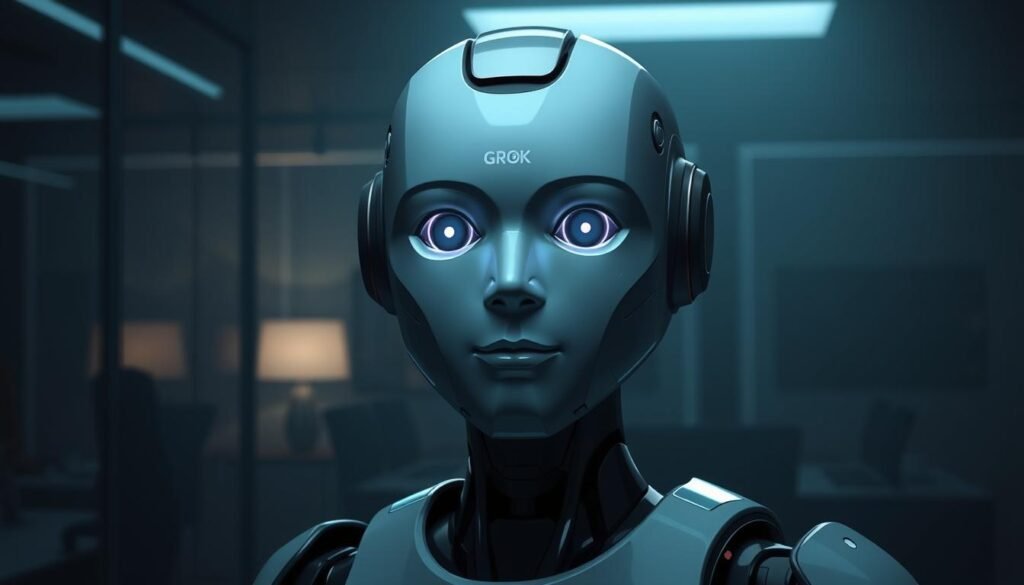Table of Contents Show
What happens when innovation meets controversy? Elon Musk’s latest AI chatbot, Grok 3, has sparked intense debates across tech and media circles. Recently unveiled during a livestream on his social media platform X, this new model promises a 10x improvement in processing power over its predecessor, Grok 2.
With comparisons to models like GPT-4 and DeepSeek, Grok 3 is positioned as a game-changer in the AI landscape. But beyond the technical specs, its integration into X raises questions about the role of media narratives in shaping public perception. How does this chatbot stand out in a crowded field of competitors?
This article dives into the details, examining both the technical benchmarks and the broader press impact. From expert opinions to real-time data, we’ll explore what makes Grok 3 a topic of such intense discussion.
Key Takeaways
- Grok 3 offers a significant leap in processing power compared to Grok 2.
- It integrates directly into the X platform, enhancing user accessibility.
- Comparisons to models like GPT-4 highlight its competitive edge.
- Media coverage plays a crucial role in shaping its public perception.
- Expert opinions and technical benchmarks provide deeper insights.
Setting the Stage: The New Era of AI Innovation
The landscape of AI is evolving rapidly, driven by bold visions and groundbreaking technology. At the forefront of this transformation is Elon Musk, whose latest venture, xAI, aims to push the boundaries of what artificial intelligence can achieve. With the launch of Grok 3, the company is taking a significant leap forward, redefining the capabilities of AI models.
Elon Musk’s Vision and xAI’s Mission
Elon Musk has always been a pioneer in technology, and his vision for xAI is no exception. The mission is clear: to understand the universe through advanced AI. This ambitious goal has led to the development of tools like Grok 3, designed to tackle complex questions ranging from cosmic origins to extraterrestrial life.
xAI’s focus on rapid iteration and daily improvements ensures that its models stay ahead of the curve. This approach not only enhances performance but also keeps users engaged with a constantly evolving platform.
From Grok 2 to Grok 3: Key Advancements
The transition from Grok 2 to Grok 3 marks a monumental shift in AI capabilities. With more than 10 times the compute power, this new version delivers unparalleled performance. During a recent livestream on social media platform X, Grok 3 showcased its ability to handle diverse challenges, from plotting space missions to creating hybrid games.
This advancement positions Grok 3 as a formidable competitor to models like OpenAI’s GPT-4. Its integration into X ensures seamless accessibility for users, further solidifying its place in the AI landscape.
As xAI continues to refine its tools, the promise of daily enhancements keeps the platform at the cutting edge. This commitment to innovation is reshaping expectations and setting new benchmarks for AI development.
On Musk, Grok, and the Press: Understanding the Impact
The release of Grok 3 has ignited a storm of media attention and expert analysis. This latest AI chatbot from xAI is not just a technical marvel but also a focal point for discussions about innovation, ethics, and competition. From glowing reviews to critical takes, the media narratives surrounding Grok 3 are as diverse as they are intense.
Media Narratives and Recent Reactions
Traditional and new media outlets have framed Grok 3’s release in various ways. Some highlight its 10x compute power leap, while others question its ethical implications. Experts like Andrej Karpathy have praised its state-of-the-art reasoning, calling it a “game-changer.”
However, not all reactions are positive. Critics point to its occasional humor misfires and sensitivity to ethical concerns. Social media platforms, especially X, have amplified both praise and criticism, making Grok 3 a trending topic worldwide.
Comparative Analysis: Grok 3 versus Competitors
When stacked against models like GPT-4 and DeepSeek, Grok 3 stands out for its integration into the X platform. This seamless accessibility gives it an edge, especially for Premium+ subscribers. Internal benchmarks show Grok 3 outperforming its predecessor in reasoning tasks.
Yet, the competition remains fierce. OpenAI’s GPT-4o and DeepSeek’s open-source model continue to set high standards. Grok 3’s introduction has added pressure on these companies to innovate further, reshaping the AI landscape.
As the media narratives and expert assessments converge, Grok 3’s impact becomes clear. It’s not just a tool but a catalyst for broader conversations about AI’s future.
Exploring Performance, Perception, and Public Response
Performance and perception are at the heart of Grok 3’s story. Since its release, this model has been scrutinized for its technical capabilities and real-world applications. From early reviews to user feedback, the response has been a mix of awe and constructive criticism.
Technical Benchmarks and Early Reviews
Grok 3 has set new standards in AI performance. Internal tests show it excels in mathematics, science, and coding tasks. Early reviews highlight its 10x compute power leap, making it a strong competitor to models like GPT-4.
Standardized test outcomes, such as AIME and GPQA, place Grok 3 at the forefront of reasoning and output quality. Blind evaluations on platforms like Chatbot Arena further confirm its advanced capabilities.
User Experiences and Expert Opinions
Users on the X platform, especially Premium+ subscribers, have praised Grok 3’s accessibility and speed. “It’s like having a personal assistant that learns with you,” one user noted. However, some have pointed out occasional humor misfires and sensitivity issues.
Experts like Andrej Karpathy have lauded its state-of-the-art reasoning. “Grok 3 is a game-changer,” he said. Yet, critics emphasize the need for ethical refinement, especially in handling sensitive information.
As the company prepares to roll out features like voice assistance and expanded API capabilities, the focus remains on balancing technical excellence with public perception. The journey of Grok 3 is just beginning, and its evolution will shape the future of AI.
Conclusion
AI innovation continues to redefine boundaries, sparking both excitement and debate. The transition from Grok 2 to Grok 3 marks a significant leap, showcasing advancements in compute power and reasoning capabilities. Media narratives and expert reviews have played a pivotal role in shaping public perception of this chatbot.
The dynamic nature of AI development ensures ongoing improvements. Competitors like OpenAI are pushing the envelope, creating a vibrant competitive landscape. As user experiences evolve, continued coverage will provide deeper insights into the model’s real-world applications.
Looking ahead, AI’s future holds immense potential. Innovations like Grok 3 are not just tools but catalysts for broader conversations about technology and society. Stay tuned as this exciting journey unfolds.











